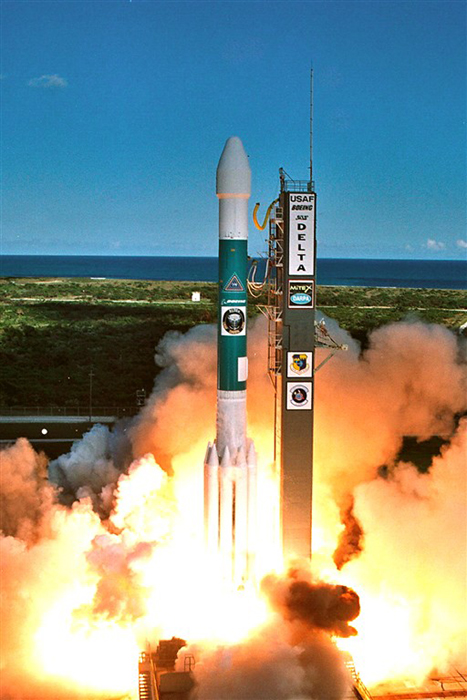Experimental Military Microsatellites Reach Orbit

Anexperimental U.S. military project to characterize the performance of twomicro-satellite trailblazers operating 22,300 miles above Earth and a prototypemaneuvering motor for small spacecraft began with a beautifulblastoff from Cape Canaveral Wednesday evening.
The Micro-SatelliteTechnology Experiment, or MiTEx, was successfullydelivered into space by Boeing's workhorse Delta 2 rocket. Launch from pad 17Aoccurred at 6:15 p.m. EDT (2215 GMT) after a short delay to clear both atechnical issue with the payload and any boats from the restricted waters underthe rocket's flight path.
The swift half-hour ascentby the three-stage rocket put MiTEx into anelliptical geosynchronous transfer orbit to mark the 67th consecutivesuccessful Delta 2 mission dating back to 1997 and the 120th success overall in122 flights since 1989.
The Delta's job has been completed but the year-long missions for the two500-pound micro-satellites of MiTEx can't begin quiteyet. The miniature spacecraft are relying on their Naval ResearchLaboratory-developed upper stage rocket motor to boost them from the currentlaunch orbit to the final destination -- a circular geostationary orbit overthe equator.
The Defense AdvancedResearch Projects Agency, Air Force and Navy have collaborated to fly thisspace mission to test technologies that could be incorporated in futuremilitary programs. MiTEx will prove whether thetechnologies -- for satellites and upper stages -- are deemed worthy or simplyneed more work.
According to informationabout MiTEx provided to Spaceflight Now by DARPAofficials, the major goals of the project include:
- Develop and flight-test a new experimental upper stage
- Investigate and demonstrate advanced space technologies such as lightweight power and propulsion systems, avionics, and spacecraft structures; commercial-off-the-shelf processors; affordable, responsive fabrication/build-to-launch techniques; and single-string components
- Demonstrate a one-year lifetime for small satellites built using these new technologies and techniques
- Demonstrate the ability to insert small satellites into geostationary orbit
- Gain experience in the operations and determine the potential utility of small satellites for future Defense Department missions in a geostationary orbit
The new upper stage burns monomethylhydrazine and nitrogen tetroxide.It is equipped with a 90-pound-force engine as well as a half-dozenfive-pound-force engines.
Breaking space news, the latest updates on rocket launches, skywatching events and more!
Specific technologies beingtested on the stage include:
- Platinum/rhodium bi-propellant attitude control thrusters
- High-performance coated columbium delta-V thruster
- Commercial off-the-shelf manual valve tested to aerospace standards
- Light-weight Inconel-718 composite overwrap pressure vessels
- Lightweight titanium propellant tanks with internal propellant management devices
- Triple junction solar cells
- Lithium-ion batteries
- A low-cost/high-performance star tracker
Themicro-satellites are bound for geostationary orbit, a unique vantage point 22,300miles above the equator that allows spacecraft to match the planet's rotationand appear fixed over one location.
Geostationaryorbit is the home of government and commercial communications satellites, plusspy spacecraft for eavesdropping reconnaissance missions and missile-launchdetection.
Once the MiTEx upper stage achieves that orbit, the micro-satellitepair will be deployed from the motor to begin running their experiments for thebenefit of military planners.
"The satellites willconduct a variety of experiments in autonomous operations and maneuvering andstation-keeping. MiTEx will also demonstrate theability to launch multiple small satellites into GEO orbit," according toDARPA officials.
Orbital Sciences built onesatellite and Lockheed Martin the other.
"Since (they were)built by different companies, they are not identical, but both will investigateand demonstrate high payoff technologies. Immediately after release, thespacecraft will commence independent operations," DARPA officials said.
Meanwhile, the Delta launchteam has little time to savor Wednesday's success. About 60 workers andmanagers involved in the MiTEx liftoff must get inposition to support next Tuesday's Delta 4 rocket launch from Vandenberg AirForce Base, California. That classified liftoff carrying a national securityspy satellite will happen sometime between 7 and 9 p.m. local time (10 p.m. -12 a.m. EDT).
For the rest of the Capecrew, assembly of another Delta 2 rocket is underway at pad 17B to launchNASA's STEREO solar observing probes July 22. The first stage and some of itsstrap-on solid boosters have been erected at the pad. Now that MiTEx is on its way, preparations for STEREO can proceed infull force.
"We've taken a breakin the action while we get MiTEx (launched).Everything is secured and we're ready to resume STEREO the day after we launch MiTEx," Rick Navarro, Boeing's director of Deltalaunch operations, said in an interview this week.
Pad 17A will be cleaned upfrom the MiTEx launch and readied to support the nextGlobal Positioning System satellite liftoff currently planned for September.
"Busy and excitingtimes," Navarro said.
Copyright2006 SpaceflightNow.com, all rightsreserved.
Justin Ray is the former editor of the space launch and news site Spaceflight Now, where he covered a wide range of missions by NASA, the U.S. military and space agencies around the world. Justin was space reporter for Florida Today and served as a public affairs intern with Space Launch Delta 45 at what is now the Cape Canaveral Space Force Station before joining the Spaceflight Now team. In 2017, Justin joined the United Launch Alliance team, a commercial launch service provider.

